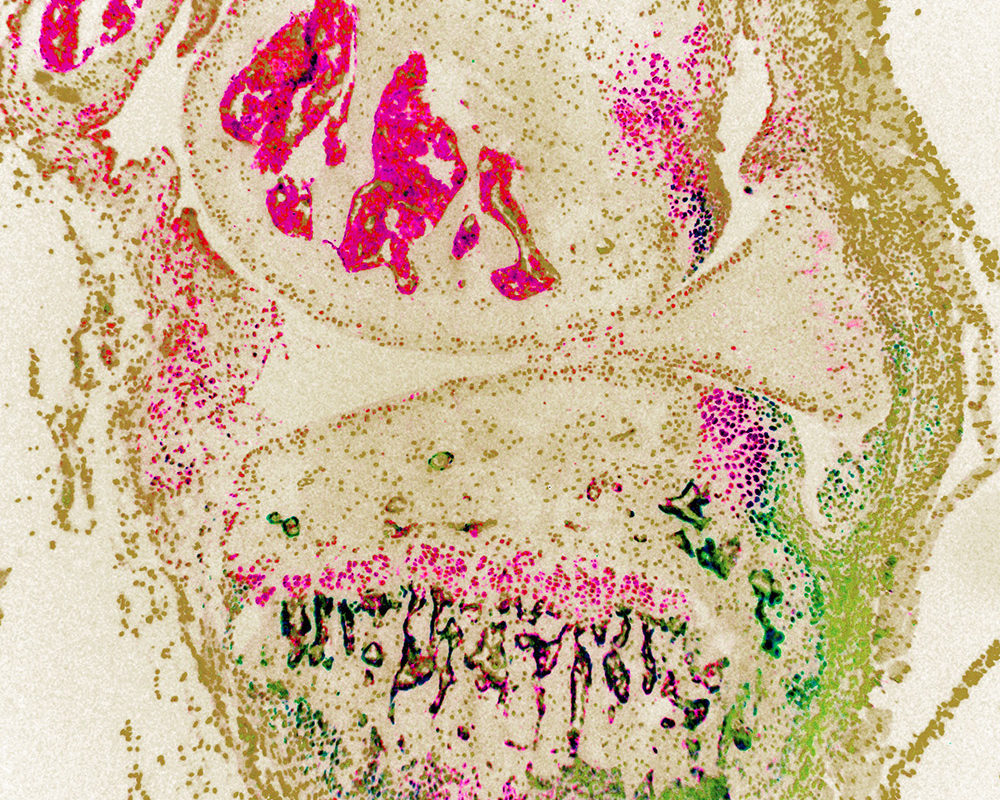
The same stem cells that heal broken bones can also generate arthritic bone spurs called osteophytes, according to a new study in the Annals of Rheumatic Diseases.
“Although these stem and progenitor cells promote healthy bone repair in other contexts, they are inappropriately activated to cause a pathological bony protuberance in the context of arthritis,” said Gage Crump, a professor of stem cell biology and regenerative medicine at USC. Crump is the paper’s co-corresponding author, along with Cosimo de Bari from the University of Aberdeen in the UK.
Led by Crump and de Bari, an international team of scientists made this discovery by studying mice that had sustained a type of knee injury that causes arthritis. In these mice, a different colored fluorescent protein labeled each of eight distinct cell populations. This allowed the scientists to view the fluorescent labels under a microscope and trace how the various cell populations contribute to the formation of arthritic bone spurs.
The major culprit turned out to be a type of stem cell with activity in a gene called Sox9, which is also involved in bone repair. At the edge of the arthritic joint, these cells contributed to cartilage outgrowths that later turned into pathological bone spurs. These cartilage outgrowths had many of the distinctive hallmarks of the cartilage seen during bone regeneration, suggesting further parallels between pathological bone spur formation and normal bone repair.
“By resolving the cellular origins of osteophytes, our work provides clues for how to target these painful bone spurs that develop at the edge of joints in many arthritis patients,” Crump said.
Crump and fellow USC Stem Cell faculty member Francesca V. Mariani began studying the role of Sox9-positive cells in bone regeneration in 2013, with support from a $400,000 pilot grant from the Regenerative Medicine Initiative, funded by the Dean of the Keck School of Medicine of USC, as well as a $2.4 million Research Project Grant from the National Institutes of Health. Crump met many of his other collaborators during his sabbatical in Australia the following year.
Additional authors include: Anke J Roelofs, Karolina Kania, Alexandra J Rafipay, Fraser Collins, and Hui Wang from the University of Aberdeen; Meike Sambale, René Gronewold, Thomas Pap, and Joanna Sherwood from University Hospital Munster; Stephanie T. Kuwahara, Joanna Smeeton, and Maxwell A. Serowoky from USC; Chrysa Kapeni and Simón Méndez-Ferrer from the University of Cambridge; Christopher Bond Little from the University of Sydney; and Lynn Rowley and John Bateman from Murdoch Children’s Research Institute in Melbourne.
Funding came from Versus Arthritis (formerly Arthritis Research UK 20775, 21156, 20050, 19429), the Medical Research Council (MR/L020211/1), the Bundesministerium für Bildung und Forschung Overload-PrevOP consortium (01EC1408F), the Innovative Medizinische Forschung Programme of the University Hospital Münster (Project I-SH121608), the National Institutes of Health (R01 AR069700), the National Health and Medical Research Council (APP1063133), the Victorian Government’s Operational Infrastructure Support Programme to the Murdoch Children’s Research Institute, the Wellcome Trust (203151/Z/16/Z), Horizon2020 (ERC-2014-CoG-648765), Cancer Research UK (C61367/A26670), and the National Health Service Blood and Transplant.
